For shippers and receivers alike, few situations are more stressful than discovering a damaged or missing container security seal when a shipment arrives at port. Cargo may have been tampered with, stolen, or otherwise compromised, causing delays, financial loss, and potential disputes. Ensuring that a shipping container is properly sealed is critical for maintaining cargo security throughout its journey, safeguarding goods from unauthorised persons accessing the container and supporting compliance with regulatory requirements.
Choosing the right shipping container seals not only protects the cargo but also provides confidence to customs authorities, shipping lines, and freight forwarders that goods are accurately declared and have not been interfered with during transit. This article explains how to select the right seal, apply it correctly, and maintain records that facilitate smooth customs clearance and reduce the risk of theft or tampering.
The Rise of Shipping Containers
Containerisation transformed global shipping in the 1970s, enabling cargo to be packed into standardised containers that could be stacked, transported, and handled efficiently regardless of the type of goods inside. This innovation increased the efficiency of the shipping industry and boosted international trade. Today, every shipping container travels thousands of miles, often across multiple countries, making shipping container security a critical component of global logistics.
However, containerisation also created new challenges. Shipping lines needed ways to track the contents of each container, while governments and customs authorities required assurances that goods were safely transported and correctly declared. Customers needed confidence that the cargo they paid for would arrive intact, without loss or interference. We have played a role in developing high-security container seals designed to protect cargo and ensure compliance with shipping regulations, helping to mitigate the risks of theft, fraud, or the transportation of illegal cargo such as contraband or drugs.
What Are Container Security Seals?
A container security seal is a one-time device designed to securely lock shipping container doors and detect any evidence of tampering whilst in transit. Once applied, the seal cannot be reopened without visible signs of such tampering, preventing reinstatement or reuse. Each seal carries a unique seal number, which must be recorded alongside shipping and customs documentation, including the Bill of Lading and other shipping documents.
Security seals are a prerequisite for international shipping, helping reduce fraud, minimise the risk of an unauthorised person accessing cargo, and alerting stakeholders to any potential tampering.
Types of Security Seals
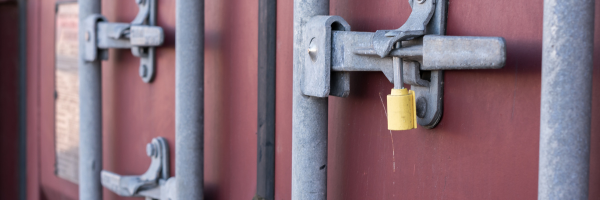
For international freight, we suggest using high-security barrier seals. These seals are engineered to withstand the physical rigours of global shipping while providing tamper evidence that deters opportunistic intrusion. Barrier seals, including bolt seals, are certified to ISO17712:2013 standards, ensuring they meet internationally recognised requirements for strength, durability, and resistance to tampering.
Bolt seals for Containers
Bolt seals are the most widely used container security seals. Comprising a pin and barrel, bolt seals are supplied as matched pairs with unique, engraved serial numbers. Universeal ensures that serial numbers are engraved on the pinhead, rather than along the pin shaft, so that they remain visible after sealing, preventing the risk of a seal being replaced or manipulated without detection. This prevents the risk of a seal being replaced or manipulated without detection. Customisation is also available, including company logos, barcodes, and colour coding, further reducing the risk of duplication and enhancing traceability across international shipping operations.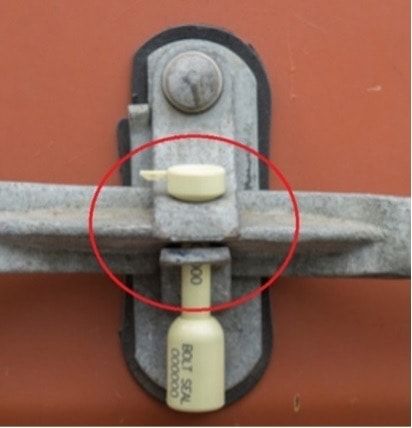
You should check that your supplier of security seals marks the serial number on the top of the pin head. (Shown in the image above.) Certain suppliers only supply bolt seals with markings down the length of the pin, which becomes obscured once sealed. If the seal number is hidden, there’s no way to confirm the pin’s serial number matches the barrel or hasn’t been tampered with. Always choose bolt seals with the serial number engraved clearly on the pin head.
Other seal types, such as cable seals and padlock seals, are suitable for specialised cargo or containers that may require multiple openings or added flexibility.
How to Properly Seal a Shipping Container
Applying a container seal correctly is essential. Bolt seals are engaged by inserting the pin into the barrel until it locks with an audible click. A properly applied seal cannot be reopened without using bolt cutters, making tampering evident.
Standard containers have two doors, with the left door closing first and the right door closing second. The most tamper-resistant location for a security seal is at the bottom of the right-hand door, where a security cam with a hole engages into a special locking keeper. This is the preferred position on containers equipped with this anti-theft locking device.
If the container lacks this modification, the only other acceptable location is on the handle attached to the locking bar nearest to the door edge (the leftmost locking handle on the right-hand door). Sealing handles on the left-hand door is not acceptable, as it opens first.
Anti-spin designs are particularly important. Inferior seals may allow the pin to be rotated out of the barrel using tools, enabling the seal to be removed and replaced without leaving visible evidence. Our anti-spin seals prevent this, ensuring every shipping container remains properly sealed and tamper-resistant.
For maximum security, up to six sealing points can be used per container, corresponding to each locking rod, though even a single correctly applied seal meets regulatory requirements.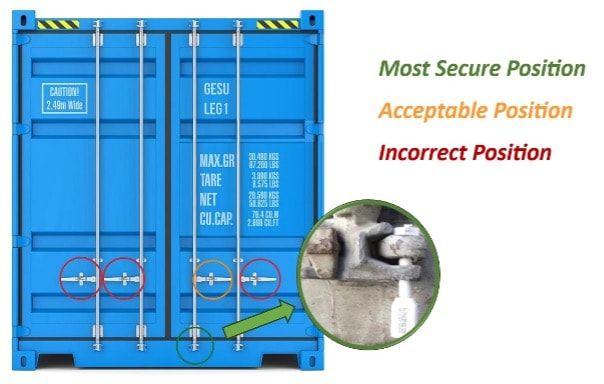
Recording Seal Application
Documenting the application of a seal is a critical aspect of container security. Ideally, an authorised staff member should witness the seal being applied to a full container and record the seal number along with timestamped photographs.
For LCL shipments, freight forwarders should provide images of the sealed container. These measures provide valuable evidence for surveyors and insurance companies, demonstrating compliance and reducing disputes in the event of damage or theft.
Customs and Shipping Line Requirements
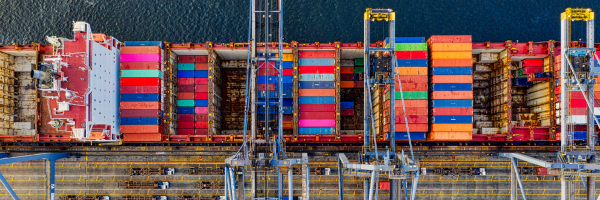
Shipping lines and customs authorities require at least one container seal for international freight. The seal number must be documented on the Bill of Lading and other shipping documentation to avoid delays during customs clearance.
Customs agencies have the authority to conduct random inspections, breaking the seal to verify cargo contents against the accompanying paperwork. After inspection, an official customs seal may be applied to re-secure the container. Breaking a customs seal without prior approval can result in penalties, so all instructions from customs officials must be followed to remain compliant.
Removing a Container Seal
When receiving a container, first inspect the seal for signs of tampering. Confirm that the seal number matches the Bill of Lading and other shipping documents. If any tampering is suspected, only remove the seal in the presence of the shipping line, freight forwarder, or maritime transport insurance representatives. Always use appropriately sized bolt cutters and wear protective eyewear, as cutting a seal requires significant force and can release debris at high speed.
What to Do if a Container Seal Is Broken or Missing
A broken or missing seal may indicate tampering or interference. If this occurs, take photos of the container and the seal, then immediately contact the shipping line, freight forwarder, and maritime transport insurance provider.
Do not open the container until authorised representatives are present. Continue photographing the container’s contents upon opening to provide evidence for any potential claims. Acting promptly and documenting each step is crucial to ensure good practice and support any subsequent insurance or legal proceedings.
Why Choose Universeal?
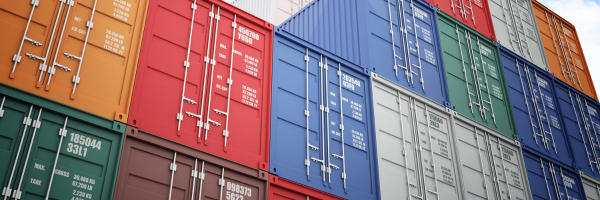
Choosing Universeal for container security seals provides peace of mind. With decades of experience supplying high-quality seals for international shipping, we ensure our products meet the highest ISO17712:2013 standards for tamper evidence and durability.
Our seals, including bolt and cable varieties, are designed to meet the evolving needs of global logistics, providing both strength and traceability. Customisation options, such as bespoke logos, serial numbers, and colour-coded seals, further enhance security and reduce the risk of replication or fraud.
Our range of high-security seals are trusted worldwide to secure containers against theft, tampering, and the movement of illegal cargo, ensuring compliance with customs and shipping line requirements while protecting your valuable goods.
Frequently Asked Questions
How many seals should be used?
Every container must have at least one seal, but up to six points can be sealed for maximum tamper evidence.
Can bolt seals be customised?
Yes, they can be engraved with company logos, serial numbers, or barcodes, and coloured for specific shipments.
What should I do if a seal is broken or missing?
Take photos, contact the shipping line, freight forwarder, and insurance immediately, and do not open the container until authorised.
Are all shipping lines the same regarding seal requirements?
No. Maersk Line, CMA-CGM, MSC and others may have specific policies. Always confirm with the shipping line.
How should seals be removed safely?
Use appropriate bolt cutters and always wear protective eyewear, cutting across the pin for safe removal.

